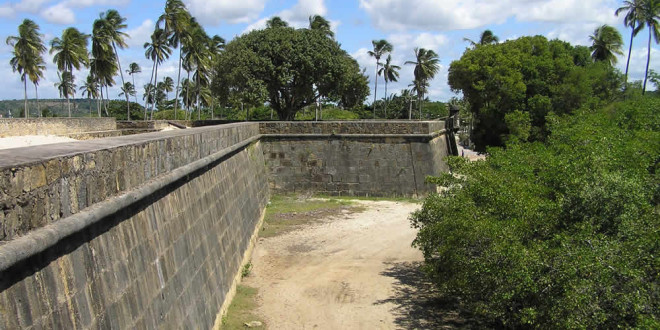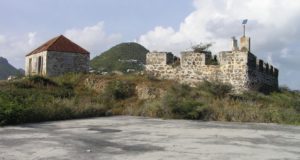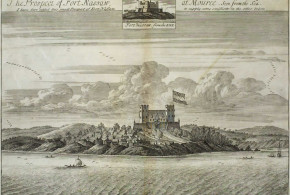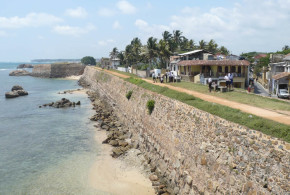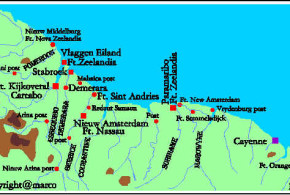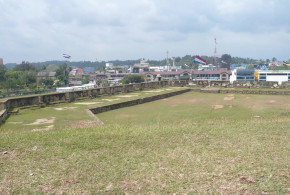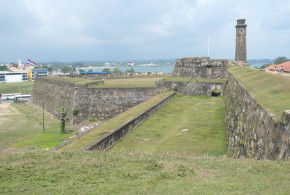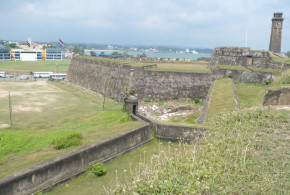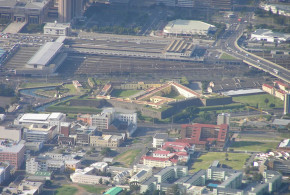Written by Marco Ramerini. English text revision by Dietrich Köster.
If you know something on colonial remains or if you have photos of such remains – they may be anywhere in the world -, send them to me. I’ll be happy to publish them on this website. Thank you. Marco. My e-mail is on the home page.
BRAZIL
Dutch surnames.
Itamaracá: Fortaleza de Orange.
Recife: Forte do Brum (1631), Forte das Cinco Pontas (1630).
GUYANA
Dutch Creole language (Berbice Creole Dutch, Skepi Creole Dutch Essequibo). The Dutch Creole languages in Guyana are nearly extinct.
Bartica: ruins of Fort Kykoveral (1616).
Berbice River: ruins of Fort Nassau.
Flag or Fort Island (Essequibo River): Fort Zeelandia (well-preserved).
JAMAICA
The Jamaica patois is a mixture of Dutch, Spanish, Portuguese, English, German etc…. In Jamaican history there was an influx of at least 1,000 Suriname settlers in the parish of St. Elizabeth, Jamaica. They were granted British Citizenship from the British when the British defeated the Dutch in Suriname in the 1600’s.
For this info my thanks to Jacqueline Brooks from United Kingdom.
NETHERLANDS ANTILLES
Dutch language, Dutch surnames.
Willemstad (Curacao): Punda Quarter (17th-18th century), Otrobanda Quarter (late 17th century), Handelskade, Waterfront, Governor’s Building, Fort Amsterdam, Fort Nassau, Riffort, Synagogue “Mikve Israel or Emanuel” (1732), Fort Kerk Garrison Church, St Anna Basilica (1734).
Oranjestad (Aruba): Fort Zoutman (18th century).
Saba:
Kralendijk (Bonaire): Fort Oranje (19th century).
Philipsburg (St. Maarten): Only a few ruins and some old cannons remain of Fort Amsterdam (1631).
Oranjestad (St. Eustatius): Fort Oranje (1636), Government‘s House (18th c..), Simon Doncker House (1770s.), Synagogue “Honen Dalim” (1739), Jewish Cemetery, ruins of Dutch Reformed Church (1755). Remains of several Dutch batteries around the Island (Fort De Windt, etc.), ruins of Lower Town (18th c.).
SURINAME
Dutch language, Dutch surnames.
Paramaribo: Fort Zeelandia (1667), Synagogue, old buildings, Hervormde Church.
Nieuw Amsterdam: Fort Nieuw Amsterdam, church.
Jodensavannah: ruins of a Jewish/Brazilian colony (1650s).
TRINIDAD AND TOBAGO
Scarborough (Tobago): part of the area around the harbour is still called Dutch Fort, but nothing remains of it.
USA
New York State: many people with Dutch descent, Dutch surnames. Streetnames in Manhattan still point to the dutch past. Parts of New York City are named after original Dutch colonial settlements: Brooklyn, after Breukelen, Harlem after Haarlem. Staten Island, was originally called Staten Eylandt after the Dutch parliament (Staten) who payed for the expeditions up the Hudson river. The place Old Town on Staten Island was originally called Oude Dorp. The current name is merely the translation of the old name into English.
For this info my thanks to Ton Zijlstra from The Netherlands
Croton on Hudson (New York State): van Cortlandt Manor (1639).
For this info my thanks to Michael D. Bathrick from USA
Albany (New York State): Thousands of artifacts and remains of a 14-foot-long, 5-foot-high wall were recovered in rescue excavations at the Dutch colonial site of Fort Orange in Albany, New York, in: “Archaeology” Newsbriefs, Volume 50 Number 3 May/June 1997
For this info my thanks to Michael D. Bathrick from USA
Branford (Connecticut): archeological remains of the Dutch fort “Goede Hoop”
For this info my thanks to Michael D. Bathrick from USA
Claverack, Columbia County: Locals pronounce it in two and a half syllables, “CLAH (va) rek.” From two Dutch words, klaver, meaning “clover,” perhaps for the scalloped marks on the bank of the river resembling three-leafed clover, and rack, a straight stretch of a waterway (the Hudson River) between two points.
For this info my thanks to Michael D. Bathrick from USA
Cobleskill, Schoharie County: Named after Jacob Kobel, an early Palatine German settler. The creek on which he lived became known as Cobus Kill by Dutch residents, and soon, the nearby community was called Cobleskill.
For this info my thanks to Michael D. Bathrick from USA
(East and North) Greenbush, Rensselaer County: A Dutch map of 1656 refers to this area as grenen bos, meaning “pine wood”.
For this info my thanks to Michael D. Bathrick from USA
Guilderland, Albany County: Named not for the Dutch coin called a guilder, but instead after the province of Gelderland in the Netherlands.
For this info my thanks to Michael D. Bathrick from USA
Kinderhook, Columbia County: Translates to “children’s corner” or “children’s point.” Along this early navigational point on the Hudson River, it is thought that objects (or real people) on the shore resembled a group of children.
For this info my thanks to Michael D. Bathrick from USA
Lindenwald, in Kinderhook: The home of the eighth U.S. president, Martin van Buren, who was born in Kinderhook of Dutch ancestry. The name refers to the property’s linden trees plus the Dutch word woud, meaning “forest.”
For this info my thanks to Michael D. Bathrick from USA
Muitzes Kill, Rensselaer County: From the Dutch word mutsje, meaning “shot glass,” probably a nickname of an imbibing settler there.
For this info my thanks to Michael D. Bathrick from USA
Moordener’s Kill: Reputed to commemorate a murder along the stream.
For this info my thanks to Michael D. Bathrick from USA
Nassau, Rensselaer County: Nassau, the county, where Prince Willem van Oranje (William of Orange) was born, was given to several places in New Netherland.
For this info my thanks to Michael D. Bathrick from USA
Plattekill, Ulster County: Plat kil refers to a calm stream. Plat means flat and describes water without strong currents or turbulence.
For this info my thanks to Michael D. Bathrick from USA
Poestenkill, Rensselaer County: Possibly from the Dutch word poesten, which means “foaming water.” But more likely from the nickname “Poest” for Jan Barentzen Wemp, who operated a farm and grist mill in the town in the 17th century. (“Poest” can mean a bump on the face or to breathe heavily, suggesting Wemp may have had a large nose or asthma.)
For this info my thanks to Michael D. Bathrick from USA
Rensselaer, Rensselaer County: Kiliaen van Rensselaer was the Dutch West India Co. director and patroon of Rensselaerswijck, encompassing what is both Albany and Rensselaer counties today.
For this info my thanks to Michael D. Bathrick from USA
Saugerties, Ulster County: Recorded in 1663 as Zagers Killetje, meaning “sawyers creek,” for its sawmills.
For this info my thanks to Michael D. Bathrick from USA
Stuyvesant, Columbia County: Named after the director general of New Netherland, Petrus (Peter) Stuyvesant.
For this info my thanks to Michael D. Bathrick from USA
Tappan Zee Bridge: A combination of the local Tappan Indians and the Dutch word zee for “sea” or an “open expanse of water.”
For this info my thanks to Michael D. Bathrick from USA
Valatie, Columbia County: Pronounced “vah-LAY-shah,” from the Dutch words, val, “falls” (waterfalls), and je, “little,” to form valletje, meaning “little falls.” The village has three falls today, created by the Valatie Kill and the Kinderhook Creek.
Vley Road in Scotia and Vly Road in Colonie: From the Dutch words vly, vley, vla vlij, which all come from vallei, meaning “valley.”
Voorheesville, Albany County: Named after an early Dutch settler Steven Coerts van Voorhees from Hees in the province of Drenthe in the Netherlands.
Watervliet, Albany County: From vlakte, meaning “overflowed plains,” or the verb vlieten, meaning “streaming” or “flowing.”
Wynantskill, Rensselaer County: Wijnant Gerritsen van der Poel was a kistemaecker (a furniture maker and carpenter) who bought a sawmill near the town on the east bank of the Hudson River.
For this info my thanks to Michael D. Bathrick from USA
Ten Broeck Street, Albany: From the Dutch settler Dirck Wesselse Ten Broeck (Dirck, son of Wessel, who lives in Broeck, a trader and the mayor of Albany from 1696 to 1698.
For this info my thanks to Peter Slegers The Netherlands
BRITISH VIRGIN ISLANDS
Road Town (Tortola): foundation remains of Fort Burt.
West End (Tortola): remains of Fort Recovery (1660).
US VIRGIN ISLANDS
Dutch Creole language (Negerhollands: St. Thomas and St. John islands). The Dutch Creole language is nearly extinct, there are remaining, only, a few second language speakers.
 Colonial Voyage The website dedicated to the Colonial History
Colonial Voyage The website dedicated to the Colonial History
